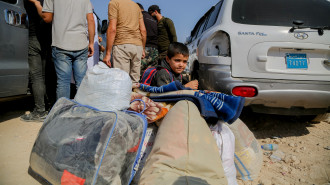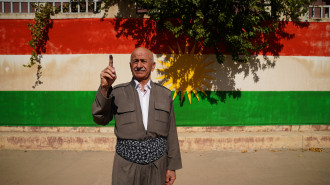A virtual Islamic State online in Gaza?
A virtual Islamic State online in Gaza?
Analysis: As a pledge of allegiance from a prominant Salafi group in Gaza in circulated by IS-supporting militants, is the movement in the strip confined to social media?
4 min read
The online popularity of the IS group in Gaza has been kept largely online [AFP]
Last Thursday, a letter was circulated in Gaza purporting to be from Jaysh al-Islam, a militant group aligned with the Doghmosh family clan.
The letter announced the group's allegiance to the Islamic State group, paid homage to Baghdadi, and said the group was part of the IS franchise in Sinai.
The Doghmosh clan comprises hundreds of members, and is thought to be responsible for the kidnapping of BBC journalist Alan Johnson in 2006.
Hamas cracked down on Doghmush power when it came into power in 2007, although are understood to have since repaired their relationship. Accordingly, if the reports are confirmed, then this will be a significant indicator of the growing influence of IS in Gaza, and the state of the strip's internal politics.
Many Gazan militants on social media shared the declaration, praising God, and celebrated the change in stance.
Yet difficulties arise surrounding the rumours, virtual threats, and pledges of alligences that are often circulated on social media by IS supporters in Gaza.
One week ago, Ansar Islamic State in Jerusalem issued a threat to Hamas - threatening "terrorist attacks to target and elimate the Hamas movement's leaders" if Khaled al-Maqdisi, a commander of a small IS-affiliate in Gaza, was not released within 24 hours.
Maqdisi was not released, and the threatened "terrorist attacks" have not yet materialised.
These virtual threats have become common among the Gazan Twitterati.
Hamas arrests Salafis
A few months ago, militants started using the hash-tag #حماس_تعتقل_السلفيين meaning "Hamas arrests Salafis", to document Hamas' arrest of Salafis in Gaza and other alleged Hamas mistreatment of militants.
Social media militants also use the opportunity to criticise liberal social practices in Gaza, such as women smoking shisha in public, and posting photos of PFLP - a leftist Palestinian political party - graduation ceremonies, which include women without hijab.
Messages of encouragement from those who left Gaza to fight with the Islamic State group in Syria are also shared - most recently a message from one militant who threatened hostages he claimed were from the Hamas movement. However, the video did appear not to be shot in Palestine.
Another notable video released from Syria included some Gazans from Rafah who had joined the Islamic State group issuing threats against Hamas.
IS-sympathising Twitter users have also advertised a website sharing details of Hamas security officers who are alleged to be "fighting supporters of the Islamic State".
Photos and other details of alleged Islamic Jihad members accused of trying to "convert people to Shia Islam" are also widely shared.
The issue of IS in Gaza first became a talking point earlier this year, when a video was released showing a couple of dozen masked militants pledging allegiance to IS in Gaza, and a poster appeared at a funeral, offering condolences from the IS group.
"[IS] will never exist here. It is only found in Iraq and the Levant, and there are no indications that the video clip was shot in Gaza," said Ziad al-Zaza, deputy prime minister in Gaza.
"As for the poster, anyone could have printed and hung it, since social networking sites are open to all and facilitate access to these groups."
In what may have been the first "virtual threat", a letter claiming to be from IS proclaimed it would target a number of liberal Gazan activists and writers. However, many of those on the list no longer reside in Gaza, and militant groups disavowed the notice.
The activism is not solely virtual; in June car bombs targeting Islamic Jihad and Hamas rocked Gaza, and many alleged that it was carried out by an IS affiliate.
Although there were multiple theories concerning who was responsible for the bombing, the suspects were named as hardline Salafis, many of whom are thought to be former members of the Qassam brigades - the armed wing of the Hamas movement - some of whom are thought to be attracted to Salafi groups due to issues such as funds, and desire for increased influence.
There are multiple Salafi and militant groups in Gaza - including Jaysh al-Islam, Shura al-Mujahedeen, Ansar Allah, Ansar Bayt al-Maqdis and Abu Noor al-Maqdisi - which leads to an air of confusion around militancy.
The relationship between Hamas and these various groups is fairly temperamental, although since Hamas came into power in 2007, it has largely managed to keep control of various militant groups in contrast to the "security anarchy" that afflicted Gaza before the group's election.
Many analysts have previously commented that IS had failed to attract supporters from Palestine, as there are already well-established militant groups here.
Meanwhile, this tiny pool of Twitter users in Gaza who support the Islamic State group manage to create an atmosphere of confusion, fear and intimidation online.
The letter announced the group's allegiance to the Islamic State group, paid homage to Baghdadi, and said the group was part of the IS franchise in Sinai.
The Doghmosh clan comprises hundreds of members, and is thought to be responsible for the kidnapping of BBC journalist Alan Johnson in 2006.
Hamas cracked down on Doghmush power when it came into power in 2007, although are understood to have since repaired their relationship. Accordingly, if the reports are confirmed, then this will be a significant indicator of the growing influence of IS in Gaza, and the state of the strip's internal politics.
Many Gazan militants on social media shared the declaration, praising God, and celebrated the change in stance.
Yet difficulties arise surrounding the rumours, virtual threats, and pledges of alligences that are often circulated on social media by IS supporters in Gaza.
One week ago, Ansar Islamic State in Jerusalem issued a threat to Hamas - threatening "terrorist attacks to target and elimate the Hamas movement's leaders" if Khaled al-Maqdisi, a commander of a small IS-affiliate in Gaza, was not released within 24 hours.
| Messages of encouragement from those who left Gaza to fight with the Islamic State group in Syria are also shared |
Maqdisi was not released, and the threatened "terrorist attacks" have not yet materialised.
These virtual threats have become common among the Gazan Twitterati.
Hamas arrests Salafis
A few months ago, militants started using the hash-tag #حماس_تعتقل_السلفيين meaning "Hamas arrests Salafis", to document Hamas' arrest of Salafis in Gaza and other alleged Hamas mistreatment of militants.
Social media militants also use the opportunity to criticise liberal social practices in Gaza, such as women smoking shisha in public, and posting photos of PFLP - a leftist Palestinian political party - graduation ceremonies, which include women without hijab.
Messages of encouragement from those who left Gaza to fight with the Islamic State group in Syria are also shared - most recently a message from one militant who threatened hostages he claimed were from the Hamas movement. However, the video did appear not to be shot in Palestine.
Another notable video released from Syria included some Gazans from Rafah who had joined the Islamic State group issuing threats against Hamas.
IS-sympathising Twitter users have also advertised a website sharing details of Hamas security officers who are alleged to be "fighting supporters of the Islamic State".
Photos and other details of alleged Islamic Jihad members accused of trying to "convert people to Shia Islam" are also widely shared.
The issue of IS in Gaza first became a talking point earlier this year, when a video was released showing a couple of dozen masked militants pledging allegiance to IS in Gaza, and a poster appeared at a funeral, offering condolences from the IS group.
"[IS] will never exist here. It is only found in Iraq and the Levant, and there are no indications that the video clip was shot in Gaza," said Ziad al-Zaza, deputy prime minister in Gaza.
"As for the poster, anyone could have printed and hung it, since social networking sites are open to all and facilitate access to these groups."
In what may have been the first "virtual threat", a letter claiming to be from IS proclaimed it would target a number of liberal Gazan activists and writers. However, many of those on the list no longer reside in Gaza, and militant groups disavowed the notice.
| The activism is not solely virtual; in June car bombs targeting Islamic Jihad and Hamas rocked Gaza |
The activism is not solely virtual; in June car bombs targeting Islamic Jihad and Hamas rocked Gaza, and many alleged that it was carried out by an IS affiliate.
Although there were multiple theories concerning who was responsible for the bombing, the suspects were named as hardline Salafis, many of whom are thought to be former members of the Qassam brigades - the armed wing of the Hamas movement - some of whom are thought to be attracted to Salafi groups due to issues such as funds, and desire for increased influence.
There are multiple Salafi and militant groups in Gaza - including Jaysh al-Islam, Shura al-Mujahedeen, Ansar Allah, Ansar Bayt al-Maqdis and Abu Noor al-Maqdisi - which leads to an air of confusion around militancy.
The relationship between Hamas and these various groups is fairly temperamental, although since Hamas came into power in 2007, it has largely managed to keep control of various militant groups in contrast to the "security anarchy" that afflicted Gaza before the group's election.
Many analysts have previously commented that IS had failed to attract supporters from Palestine, as there are already well-established militant groups here.
Meanwhile, this tiny pool of Twitter users in Gaza who support the Islamic State group manage to create an atmosphere of confusion, fear and intimidation online.

![Palestinians mourned the victims of an Israeli strike on Deir al-Balah [Getty]](/sites/default/files/styles/image_684x385/public/2024-11/GettyImages-2182362043.jpg?h=199d8c1f&itok=xSHZFbmc)


![The law could be enforced against teachers without prior notice [Getty]](/sites/default/files/styles/image_684x385/public/2178740715.jpeg?h=a5f2f23a&itok=hnqrCS4x)
 Follow the Middle East's top stories in English at The New Arab on Google News
Follow the Middle East's top stories in English at The New Arab on Google News


